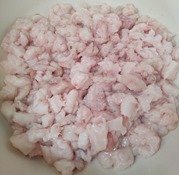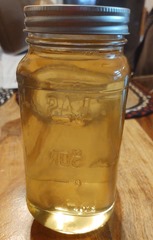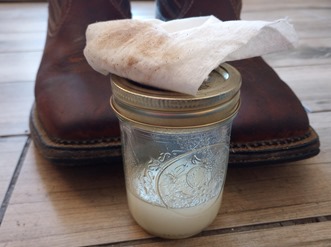Trigger Warning: This post involves harvesting a wild animal by a studly man. That means it wasn’t me.
Another task that I never thought would be done in my life. A friend of a friend harvested a beautiful big black bear during archery season. First, think about that. A man used a bow and arrow to shoot and kill a huge black bear. That concept is pretty amazing to me. Anyway, as part of the processing, my good friend received some large chunks of fat as well as some other pieces of meat from our super manly stud of a man that shot the bear. I like to think that he ran after it and finished off the bear with a big knife, but I know that didn’t happen.
Anyway, not long ago, I saw a YouTube video about rendering pig fat into lard. Imagine the light bulb going off over my head. The process seemed to be the same for bear, and I did my super hard core research to verify the process. Yep, YouTube had several great videos on rendering bear fat into grease. I am very good at researching. I put “render bear fat” into the search bar in YouTube and found what I needed.
Anyway, after I was confident that I could do it, I asked for a chunk of bear fat for my experiment. Since nobody had any plans to do anything with the huge blocks of fat, I received a couple of large chunks.
chunk of bear fat for my experiment. Since nobody had any plans to do anything with the huge blocks of fat, I received a couple of large chunks.
Some back ground. Rendering pig fat into lard, beef fat into tallow, and dear or elk fat into tallow are all very similar processes. The result of rendering has a different name depending on the animal fat that was used. In the case of bear fat, it is rendered into grease. I refer to it as oil most of the time because it is a nice clear fluid.
The basic steps are very similar. 
- Get Fat – Gather all of the good fat that you can from the animal. Remove any meat that can be easily cut away. Meat pieces won’t cause the result to be worse, but it is best to not add the flavor of the meat and the color that it adds. A good rendering will be close to neutral when it comes to the flavor.
- Cut up Fat – Cut the fat, or grind it up, into small pieces. The smaller the better because it will “melt” easier if the pieces are smaller.

- Cook down Fat – Heat up the fat and cook it down, stirring on a regular basis. Some people recommend starting with some water to prevent the fat from scorching. Others recommend putting just a little of the fat in until it begins to melt, and then you can add more. I didn’t have any issues with it scorching. Maybe the key is to use smaller pieces and using a nice cast iron pot.
- Continue Cooking – Keep cooking/melting the fat. Stir it as needed to make sure the fat all cooks down at the same time.

- Remove the Cracklings – Turn the heat down or turn off the heat completely. Save those cracklings. They are delicious with some salt and some other seasonings. I used a little Tony Chachere’s Bold Creole Seasoning. The cracklings make great little snacks, and I also used the cracklings in my burritos later that night. Damn, it was delicious!!!
- Filter – Once all the cracklings have been removed, filter the oil/grease through a strainer. You may want to use something finer like a coffee filter to get the oil/grease as clean as you can.
The result? Lots of great bear oil/grease that you can be used to waterproof your boots or  other leather goods, and you can use it for cooking. Some people say that the bear grease will grow hair for bald men.
other leather goods, and you can use it for cooking. Some people say that the bear grease will grow hair for bald men.
I gave away several pints of bear grease to those that would appreciate it the most. I used some for cooking to see how it tasted, and I liked it. However, I liked how it worked on my boots, so that is how I have been using it.
Once the grease cooled down, it started to solidify some. I pressure canned the grease for long-term storage because I doubt I will ever have a friend shoot a huge bear with a bow and arrow ever again.
